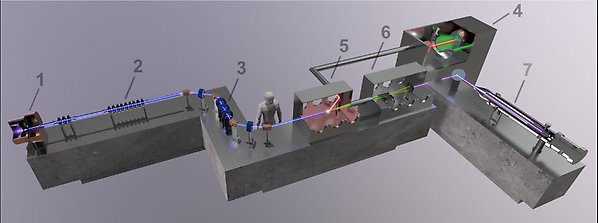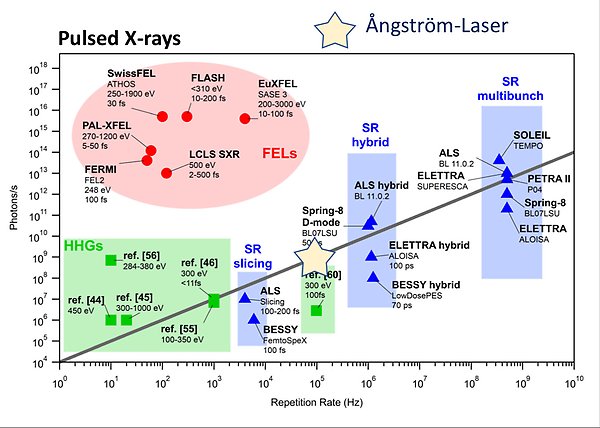Accelerator-based photon sources

Conseptual design for the Ångström Laser based on a superconducting electron accelerator and an optical undulator: 1. electron gun, 2. superconducting accelerator cavity, 3. bunch compressor, 4. drive laser for optical undulator, 5. optical undulator, 6. X-ray monochromator, 7. photoelectron spectrometer. The illustration only depicts a photoelectron spectrometer as the end station. Other end stations are not shown.
We develop novel accelerator-based photon sources. Examples range from attosecond-pulse x-ray free electron lasers to novel compact femtosecond x-ray sources such as the Ångström Laser.
One of our proposed photon source, called the Ångström Laser, is expected to be complementary to existing XFELs and synchrotrons. As a medium-scale X-ray facility, this laser will fill the capability gap between synchrotrons and X-ray Free Electron Lasers. This will be a discovery machine for new materials and novel ustainable technologies.
The Ångström Laser will exploit superconducting accelerator technology and allow high repetition rate femtosecond flashes of X-ray radiation for exploring materials on the ultimate quantum level of moving atoms and electrons. The conceptual design simulations promise a flux of 10^9 photons/s in a broad energy bandwidth ideally suited for time-resolved X-ray absorption spectroscopy and X-ray scattering, and 10^8 photons/s in a narrow energy bandwidth ideal for time-resolved X-ray photoemission spectroscopy.

Pulsed X-ray facilities over the world with the MAX IV synchrotron and the SXLsoft X-ray free electron laser project in Sweden. Also shown are high-harmonic generation laser setups in Boulder, Berkeley, Umeå, Zürich and Lund.
With photon energies of 2-13 keV, this will access X-ray absorption edges in transient absorption of important elements in catalysis and make possible depth profiling in diffraction to access interfaces in materials. High repetition rate of the femtosecond X-ray flashes, which is an order of 100 kHz, will enable probing functional materials as their properties evolve on intrinsic time- and length scales.
An operation principle of the Ångström Laser is based on the interaction of a short electron bunch with infrared photons in an optical undulator created by a high-intensity coherent light pulses, the so-called Inverse Compton Scattering effect. Within the landscape of compact X-ray sources based on such a princple, the Ångström Laser is competitively positioned.
In conventional X-ray facilities (synchrotrons and XFELs) X-ray pulses are generated from electron bunches in permanent-magnet undulators up to 100 m in length. Here we propose to replace these permanent-magnet undulators by the significantly more compact “optical undulator” of an intense optical laser field. In such a so-called inverse Compton source, laser pulses collide head on with electron
bunches at relativistic speeds. The strong laser field acts very much like the magnetic field of a conventional undulator wiggling the electrons back and forth emitting X-rays in the process. This is a well-known principle that is being used in various places worldwide to generate X-rays. Now, here in Uppsala, with the existing unique instrumentation and experience combined with the now available new high-power commercial laser systems, we want to realize an optical undulator for a new ultrafast X-ray source in Sweden. The synergy of this optical undulator with a high repetition rate superconducting accelerator will make available the Ångström Laser – a femtosecond X-ray source with, due to the dramatically increased repetition rate, radically increased photon flux compared to existing inverse Compton sources. Our simulations indicate for the Ångström Laser baseline design a flux ranging from 109 photons/s in a 1% energy bandwidth (for use of polychromatic X-ray radiation) to 108 photons/s in a 0.02% energy bandwidth (for use of monochromatic X-ray radiation) at 2-8 keV X-ray energy and a
100 kHz repetition rate (see Table 1). Existing infrastructure at Uppsala University’s FREIA Laboratory is essential for the innovative design of this X-ray source.
